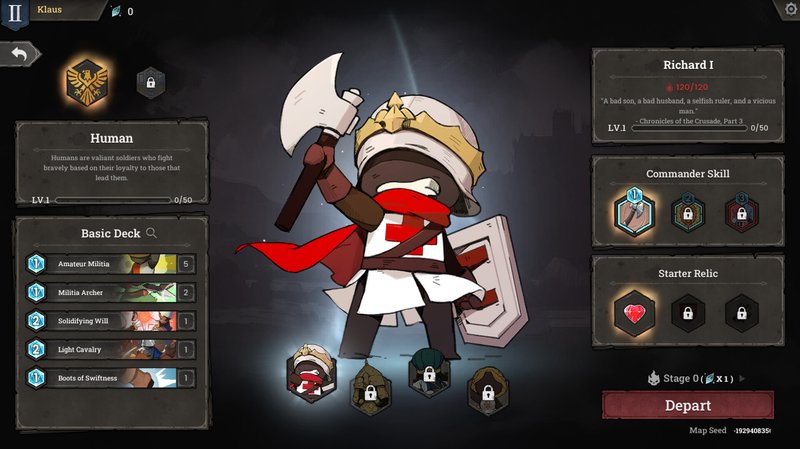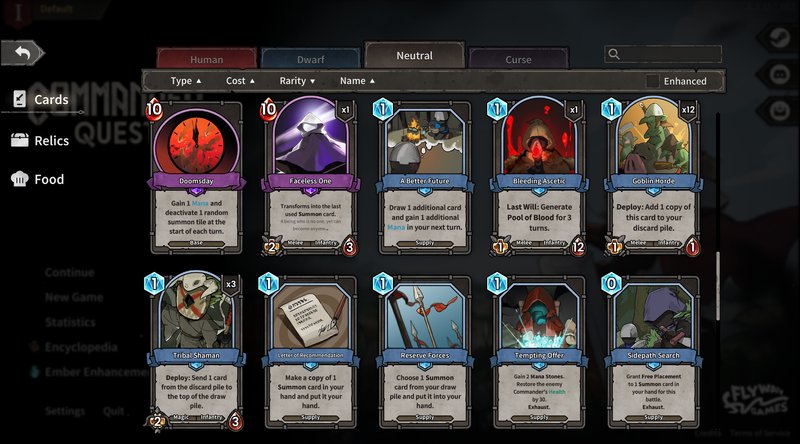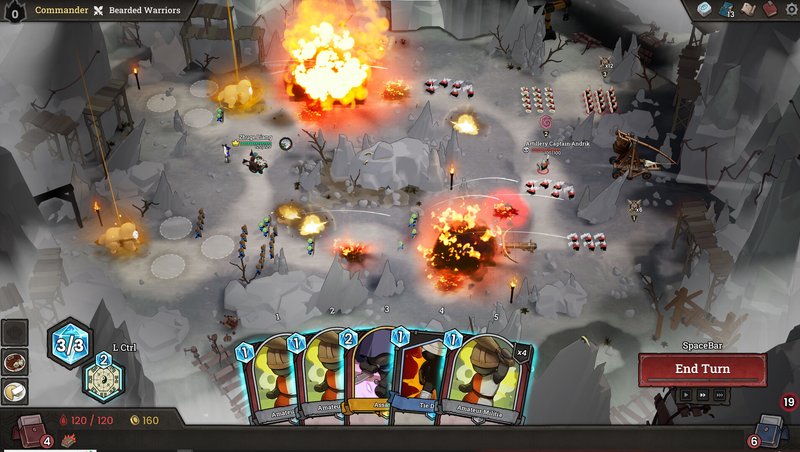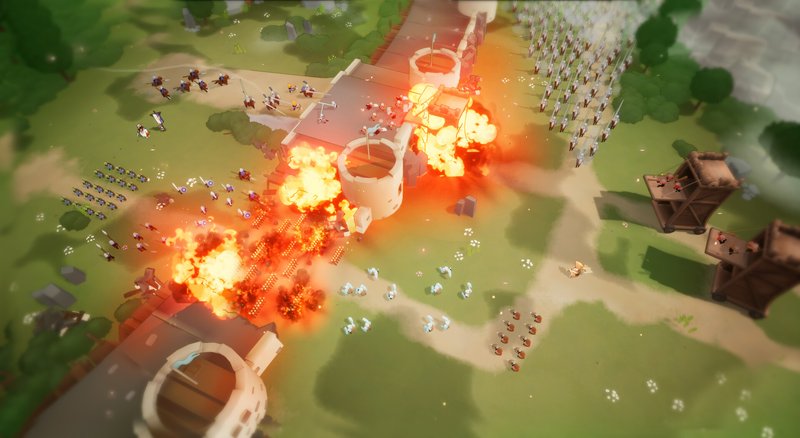Review: Commander Quest
Commander Quest: An Exercise in Tactical Mediocrity
In the increasingly saturated realm of deckbuilding roguelikes, one must approach each new entrant with a discerning eye and measured expectations. Commander Quest, the latest offering from Flyway Games, attempts to marry the cerebral pleasures of card collection with the visceral delights of tactical warfare—a combination that, while not without precedent, certainly warrants examination. Having spent a considerable number of hours with the title (meticulously documented in my leather-bound notebook), I find myself in the peculiar position of being simultaneously intrigued and underwhelmed.
Initial Impressions and Interface Design
Upon first launching Commander Quest, one is greeted with a character selection screen that establishes the game’s aesthetic direction—a minimalist, vaguely medieval presentation that, while charming in its simplicity, lacks the sumptuous visual flourish of more distinguished entries in the genre.

The interface presents itself with commendable clarity, if somewhat pedestrian execution. The starting deck composition (a rudimentary collection of militia units and basic equipment) suggests a game that begins with appropriate restraint, though one hopes for more substantial strategic options as progression unfolds. The locked Commander Skills and Starter Relics hint at future possibilities, but the initial offering feels rather sparse for those accustomed to more robust starting configurations.
What is particularly notable, though perhaps not revolutionary, is the faction designation system. The “Human” faction, with its rather uninspired description of valiant soldiers, lacks the nuanced mechanical identity one finds in more sophisticated titles. One cannot help but think of the intricate factional interplay in Across the Obelisk, where each grouping offers distinct tactical advantages beyond mere thematic window dressing.
Mechanical Framework and Strategic Depth
The core gameplay loop of Commander Quest revolves around the now-familiar paradigm of procedurally generated encounters, deck refinement, and incremental progression. Where the game attempts to distinguish itself is in the translation of card effects into tactical battlefield engagements—a promising conceit that unfortunately suffers from inconsistent execution.
The card selection interface displays a taxonomical structure that sorts options by race types—Human, Dwarf, Neutral, and Curse—which suggests potential for interesting tribal synergies. However, the implementation of these synergies often feels underdeveloped, with many cards existing as isolated mechanical islands rather than components of a cohesive strategic framework.

Of particular interest are the higher-cost cards like “Doomsday” and “Faceless One,” which demonstrate a flair for dramatic effects that can potentially shift the tide of battle. Yet, for each of these moments of mechanical intrigue, there are multiple instances of cards with effects so pedestrian that one wonders if they were designed merely to dilute the card pool—a practice I’ve criticized extensively in my treatise on “Probability Management in Digital Deckbuilders,” which several of my colleagues have described as “transformative” (though I digress).
The resource management system employs a standard energy framework represented by a hexagonal counter—functional, if derivative of Slay the Spire’s implementation. This is not inherently problematic; indeed, there is value in adhering to established conventions. However, one hopes for at least modest innovation in a genre that has seen such prolific expansion in recent years.
Tactical Combat and Visual Presentation
Where Commander Quest makes its most valiant attempt at distinction is in its tactical combat layer. Cards played from hand materialize as units on a battlefield, engaging in automated combat that unfolds according to predetermined behaviors. This translation from card to combatant creates a satisfying connection between deck construction and tactical outcome, though the player’s agency in the moment-to-moment combat feels somewhat limited.

The battlefields themselves are rendered with a minimalist aesthetic that prioritizes readability over spectacle—a commendable choice, if somewhat lacking in visual splendor. The particle effects from explosions and spell impacts provide welcome visual feedback, though they rarely reach the heights of atmospheric excellence seen in titles like Inscryption.
Particularly striking are the night encounters, where the contrast between the darkened landscape and the luminous glow of combat effects creates moments of genuine visual appeal. The snow-covered battlefield, with its stylized evergreen trees rendered in a sophisticated purple-blue palette, demonstrates that the art direction is not without merit, even if it lacks the consistent excellence of the genre’s finest examples.

The siege scenarios present some of the most visually compelling moments in the game. The aerial perspective of circular fortification structures connected by defensive walls, with dramatic conflagrations spreading across the terrain, creates a diorama-like effect that is genuinely pleasing to observe. The particle effects and lighting in these sequences are quite spectacular, reminiscent of the masterful work in Divinity: Original Sin 2, though perhaps with a more restrained palette.

Progression and Replayability
The progression system in Commander Quest follows the well-established pattern of run-based advancement, with each attempt—successful or otherwise—contributing to a persistent unlocking of new cards, relics, and commander skills. This framework provides sufficient motivation for repeated engagement, though the rate of meaningful unlocks feels somewhat miserly compared to more generous implementations in the genre.
The procedural generation of encounters shows competent execution, with sufficient variation to prevent immediate staleness. However, after approximately fifteen hours of play (meticulously documented with my vintage Montblanc fountain pen), patterns begin to emerge with disappointing regularity. The tactical scenarios, while initially engaging, eventually reveal themselves to be variations on a limited set of themes rather than truly dynamic challenges.
Of particular concern is the balancing of later commanders, which demonstrate a troubling lack of cohesion with the global card pool. This suggests either rushed development or insufficient playtesting—neither of which inspires confidence in the game’s long-term viability.
Production Values and Technical Performance
From a technical perspective, Commander Quest performs adequately on high-end hardware, maintaining stable frame rates even during the more visually busy combat sequences. The interface responsiveness is commendable, with card selection and placement feeling appropriately tactile.
The audio design, while functional, lacks memorable elements that might elevate the overall experience. The soundtrack provides appropriate atmospheric accompaniment without ever threatening to be memorable beyond the context of play—a missed opportunity for creating a more immersive experience.
The localization appears competent, though I noted several instances of awkward phrasing that suggest translation work of merely adequate quality rather than the meticulous attention to linguistic nuance one might hope for in a premium offering.
Conclusion: A Competent but Unremarkable Entry
In the final analysis, Commander Quest presents itself as a competent but ultimately unremarkable entry in the deckbuilding roguelike genre. Its attempt to bridge card mechanics with tactical combat demonstrates conceptual promise, but the execution lacks the refinement and depth that would elevate it to the pantheon of essential genre experiences.
For the asking price of $9.59, it offers sufficient content to justify the expenditure for dedicated enthusiasts of the genre. However, those seeking truly innovative mechanical frameworks or exceptional production values would be better served looking elsewhere—perhaps to the criminally underappreciated Night of the Full Moon or the mechanically sublime Monster Train.
Commander Quest is not without merit, and I can envision it finding an appreciative audience among those with more modest expectations or less extensive experience with the genre’s finest offerings. However, for those of us who have spent countless hours exploring the depths of strategic possibility in digital deckbuilders, it represents a diversion rather than a destination—a competent imitation rather than a worthy evolution.
As I close my leather-bound notebook and cap my vintage Montblanc fountain pen, I find myself hoping that future updates might address the game’s shortcomings and realize its conceptual promise. Until then, it remains a curiosity rather than a revelation—a footnote rather than a chapter in the ongoing evolution of the deckbuilding genre.
Elm Whitmore, Ph.D.
Oxford University
Score
Overall Score: 5/10
Developer: Flyway Games, Inc.
Release Date: Apr 4, 2025
Steam Page: Commander Quest